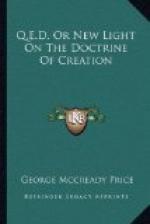One of the great outstanding ideas of geology as usually taught is that life has been on the globe for many millions of years, that in fact there has been a graded succession of different types of life in a well defined invariable order, from the lower and more generalized to the higher and more specialized. Quite obviously this succession of life was antagonistic to the former views of a literal Creation; and only on this supposed fact as an outline has the modern theory of biological evolution been built up. For if geology cannot furnish the most unquestionable proof that life has occurred in a very definite and invariable order, what is the use of talking about the development of one form of life into another by a gradual process of evolution?
One of the highest scientific authorities in America, Prof. Thomas Hunt Morgan, of Columbia University, has recently said, “The direct evidence furnished by fossil remains is by all odds the strongest evidence that we have in favor of organic evolution."[33] Accordingly we purpose to examine carefully what this by all odds “strongest evidence” is like.
[Footnote 33: “A Critique of the Theory of Evolution,” p. 24.]
II
As with some of the other facts with which we have had to deal in previous chapters, a correct understanding of the questions involved can best be obtained by examining the history of the development of the science.
The first man with whom we need to concern ourselves is A.G. Werner, a teacher of mineralogy in the University of Freiberg, Germany. For three hundred years his ancestors had been connected with mining work, and he, though possessing little general education, knew about all that was then known regarding mineralogy and petrology. He wrote no books; but by his enthusiastic teaching he gathered as students and sent out as evangelists hundreds of devoted young scientists who rapidly spread his theories through all the countries of Europe.
“Unfortunately,” says Zittel, “Werner’s field observations were limited to a small district, the Erz Mountains and the neighboring parts of Saxony and Bohemia. And his chronological scheme of formations was founded on the mode of occurrence of the rocks within these narrow confines."[34]




